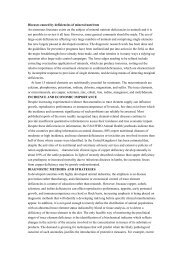Technological and Technical Development of Tobacco Drying
Technological and Technical Development of Tobacco Drying
Technological and Technical Development of Tobacco Drying
You also want an ePaper? Increase the reach of your titles
YUMPU automatically turns print PDFs into web optimized ePapers that Google loves.
INTRODUCTION<br />
Harvesting <strong>and</strong> curing (drying) affects the quality <strong>and</strong> even the yield <strong>of</strong> flue-cured tobacco.<br />
Favorable curing conditions bring out the best properties <strong>of</strong> the leaves, but the final quality depends more<br />
on the characteristics <strong>of</strong> the leaves at harvest than on curing. Optimum results in curing can be obtained<br />
only with uniform, well-matured crops. But good leaves from the field may be partly or completely<br />
spoiled by improper h<strong>and</strong>ling or loading practices, poor curing, or inadequate curing facilities. Quality<br />
may be reduced after the cure by casing (conditioning) the leaves to high moisture content. Such leaves<br />
"redden", <strong>and</strong> mold may develop in the storage piles (Collins-Hawks, 1993).<br />
It is unambiguous that the good <strong>and</strong> economical curing is influenced by the growing technology,<br />
preparation for curing <strong>and</strong> itself the curing technology. In addition to these things, we can reduce the fuel<br />
consumption with different technical methods as making use <strong>of</strong> solar energy or regaining the waste heat.<br />
Taking the Hungarian conditions into account I have been making the following research works <strong>and</strong><br />
experiments in realization <strong>of</strong> energy savings <strong>and</strong> improvement <strong>of</strong> the quality under curing flue-cured<br />
tobacco:<br />
− Influence <strong>of</strong> the preceding technology elements for the energy need <strong>of</strong> curing, <strong>and</strong> the best quality;<br />
− Influence <strong>of</strong> the curing process for the energy scales;<br />
− <strong>Development</strong> <strong>of</strong> tobacco barn constructions in decreasing <strong>of</strong> the energy consumption, <strong>and</strong> influencing<br />
<strong>of</strong> the feature <strong>of</strong> end product;<br />
− Applications <strong>of</strong> supplementary technical solutions for speeding up <strong>of</strong> the efficiency.<br />
TECHNOLOGICAL DEVELOPMENTS<br />
In Hungary You can find exclusively h<strong>and</strong>-harvested tobacco. There are a lot <strong>of</strong> troubles under<br />
h<strong>and</strong> harvesting in the tobacco estates. Due to the shortcomings <strong>of</strong> the growing technology <strong>and</strong> the<br />
weather conditions, the tobacco <strong>of</strong>ten ripens hardly or nearly at the same time.<br />
The workers <strong>of</strong>ten harvest the unmaturated leaves <strong>and</strong> they mix the different levels because do not have<br />
so much practice or are not interested in quality.<br />
The harvesting influences not only the quality <strong>of</strong> the drying but also the energy consumption, because it is<br />
necessary more energy to cure the green, unriped <strong>and</strong> mixed leaves - the experiences showed it.<br />
The ripeness <strong>of</strong> the leaves at harvest is one <strong>of</strong> the most important factors affecting the final quality. For<br />
best results, lugs should be overripe, the cutter, middle <strong>and</strong> tip leaves ripe.<br />
Quality <strong>of</strong> the cure depends on the uniformity <strong>of</strong> the harvested leaves in ripeness <strong>and</strong> position on the<br />
stalk. To attain such uniformity the plants must be uniform in size <strong>and</strong> age, <strong>and</strong> the field uniform in<br />
fertility. Agronomic practices designed to create uniform fertility, minimize replanting, <strong>and</strong> maintain<br />
uniform growths are highly important (Davis – Nielsen, 1999).<br />
It should be harvested no more than two lugs, or no more than three cutter <strong>and</strong> middle leaves per plant.<br />
They must leave four or five tips for the final priming, as a smaller number <strong>of</strong>ten ripen too slowly,<br />
particularly in cool, wet weather.<br />
It is best to avoid harvesting during wet weather, or for 2 or 3 days after a heavy rain. Under such<br />
conditions leaves may temporarily revert to a less mature stage as a result <strong>of</strong> renewed nutrient uptake by<br />
the plants. These leaves are difficult to cure, <strong>and</strong> the final quality is usually poor. The effect <strong>of</strong> wet<br />
weather is most noticeable if the soil fertility is high or moisture has been deficient.<br />
Leaves are <strong>of</strong>ten severely damaged at the time <strong>of</strong> picking. We must h<strong>and</strong>le them carefully to avoid<br />
breakage <strong>and</strong> bruising, particularly those primed early in the morning or in wet weather.<br />
For reaching successful harvesting we have suggested a new tobacco growing technology with the help <strong>of</strong><br />
the ULT, <strong>and</strong> have been following with attention to the seedbeds, transplanting, cultivating <strong>and</strong> plant<br />
protection.















